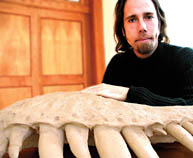Extreme Research: Traveling the Globe
Extreme Research: Traveling the Globe McGill University
User Tools (skip):
Extreme Research: Traveling the Globe
Undeterred by dangerous conditions, McGill paleontologist Hans Larsson, BSc '94, is digging deep into the past, no matter where it takes him.

Being stalked by polar bears. Risking hypothermia in the constant damp of near-freezing temperatures, buffeted by 120-kilometre-an-hour winds that whip up a penetrating mix of snow and sleet. Knowing that should your satellite phone give out, you are without means of contacting the outside world. Recognizing that in the event of an emergency, help is at least six hours - but, more realistically, given the frequency of severe weather, as much as five days - away.

Such were the hazards braved by McGill paleontologist Hans Larsson, BSc'94, and his five-member team during the course of a three-week research expedition to Bylot Island, Nunavut, in Canada's high Arctic, this past August. All in the name of filling in some of the gaping blanks in our understanding of the past 100 million or so years of evolution.
"This was definitely the most extreme environment I've ever been in," affirms Larsson, who has done field work in Morocco, Brazil, Argentina and Niger. Which is to say, he's no stranger to extreme environments.
Most unnerving were the polar bears, one of which followed the party for nearly a kilometre. Happily, its curiosity wasn't a manifestation of hunger, and it eventually left them to their work.
Natalia Rybczynski of the Canadian Museum of Nature in Ottawa was one of the team members. Brought along both for her scientific expertise in paleo-mammology - that is, evolutionary development in mammals - and for her experience from two previous journeys to the Arctic, she recalls, "It was very stressful. You had to be constantly prepared to grab for the gun we carried just in case. If a bear attacks, there isn't a lot of time to think or recover if you miss your shot."
Arctic Journey
This first expedition was a pilot effort preceding what will be a five-year cycle of Arctic exploration. It gave Larsson an opportunity to acclimatize himself to the environment and cut large swaths across the terrain (covering as much as 25 kilometres on some days), and to do some surface prospecting in order to get an idea of the kind of fossil records that might be preserved in the sub-strata of Bylot.
He chose this particular island because of its relative accessibility and because dinosaur bones had been found there back in 1989. Furthermore, the literature led him to expect the specific geology often associated with fossilization. Disappointingly, it turned out to be inaccurate.
"Most Arctic geology has only been looked at once or twice," he explains. "Because Bylot shows no mineral potential, it is one of the least worked islands, which accounts for the errors."
The thrust of his research is to determine how terrestrial populations changed during the course of the Mesozoic era, between 250 million years ago - when the Earth's land mass was one - and 65 million years ago, when it split into the continental formations we see today. Over this period, the Arctic went from hot and arid to lush tropical to a temperate climate with seasonal freezing. Larsson hopes to collect enough evidence to build a database accounting for how a variety of flora and fauna evolved in relation to these environmental variations. With our own climate undergoing potentially catastrophic shifts, such research has direct relevance today.


